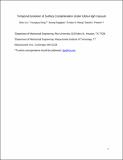Temporal Evolution of Surface Contamination under Ultra-high Vacuum
Author(s)
Liu, Zhen; Song, Youngsup; Rajappan, Anoop; Wang, Evelyn N.; Preston, Daniel J.
DownloadAccepted version (428.9Kb)
Open Access Policy
Open Access Policy
Creative Commons Attribution-Noncommercial-Share Alike
Terms of use
Metadata
Show full item recordAbstract
Ultra-high vacuum (UHV) is essential to many surface characterization techniques and is often applied with the intention of reducing exposure to airborne contaminants. Surface contamination under UHV is not well-understood, however, and introduces uncertainty in surface elemental characterization or hinders surface-sensitive manufacturing approaches. In this work, we investigated the time-dependent surface composition of gold samples with different initial levels of contamination under UHV over a period of 24 h with both experiments and physical modeling. Our results show that surface hydrocarbon concentration under UHV can be explained by molecular adsorption-desorption competition theory. Gold surfaces that were initially pristine adsorbed hydrocarbons over time under UHV; conversely, surfaces that were initially heavily contaminated desorbed hydrocarbons over time. During both adsorption and desorption, the concentration of contaminants tended toward the same equilibrium value. This study provides a comprehensive evaluation of the temporal evolution of surface contamination under UHV and highlights routes to mitigate surface contamination effects.
Date issued
2022-01Department
Massachusetts Institute of Technology. Department of Mechanical EngineeringJournal
Langmuir
Publisher
American Chemical Society (ACS)
Citation
Liu, Zhen, Song, Youngsup, Rajappan, Anoop, Wang, Evelyn N and Preston, Daniel J. 2022. "Temporal Evolution of Surface Contamination under Ultra-high Vacuum." Langmuir, 38 (3).
Version: Author's final manuscript
ISSN
0743-7463
1520-5827